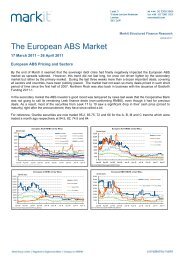The CDS Big Bang Research Report - Markit.com
The CDS Big Bang Research Report - Markit.com
The CDS Big Bang Research Report - Markit.com
You also want an ePaper? Increase the reach of your titles
YUMPU automatically turns print PDFs into web optimized ePapers that Google loves.
<strong>CDS</strong> <strong>Big</strong> <strong>Bang</strong>: Contract and Convention Changes<br />
<strong>The</strong> credit event auction mechanism is a transparent and efficient process to determine a final price post credit event,<br />
and settle trades physically or with cash. All inputs into the auction process are made freely available at<br />
www.creditfixings.<strong>com</strong>.<br />
Proposal:<br />
<strong>The</strong> credit event auction methodology will be hardwired into standard <strong>CDS</strong> contracts on a global basis while leaving only<br />
the specific auction settlement terms for each credit event to be determined shortly prior to the auction. For a description<br />
of the credit event auction methodology, please see “Credit Event Auction Primer” jointly published by <strong>Markit</strong> and<br />
Creditex. This document can be found at www.markit.<strong>com</strong>/cds. <strong>The</strong> auction methodology is expected to remain<br />
consistent across auctions but can be amended by a supermajority (80%) of the DC after a public <strong>com</strong>ment period.<br />
<strong>The</strong> auction settlement terms are attributes best left settled based on the specifics for each particular credit. It is<br />
conceivable that there may not be a credit event auction if the outstanding volume of trades is so small as to not merit<br />
one. Auction specific terms will be set by a majority vote of the DC and published prior to the auction. <strong>The</strong>se terms<br />
include the following: 1) auction date, 2) initial bidding information publication time, 3) subsequent bidding information<br />
publication time, 4) inside market quotation amount, 5) maximum inside market bid-offer spread, and 6) minimum<br />
number of valid inside market submissions.<br />
Deliverable obligations for each credit event will be determined by the DC for each auction. A simple majority vote of the<br />
DC is sufficient as long as the result is unchallenged. If challenged, an 80% vote or External Review would be required.<br />
Hardwiring of the auction mechanism has a target implementation date of April 8 th .<br />
Effective Date for Credit Event & Succession Event Purposes<br />
<strong>The</strong> Situation Today:<br />
Under the current <strong>CDS</strong> contract, protection against a credit event begins on the business day following the trade date.<br />
As such, two trades buying and selling <strong>CDS</strong> on the same reference entity for the same notional amount but on different<br />
days are not truly offsetting. For example, assume an investor sold protection today and then entered into an offsetting<br />
transaction to close off the exposure a week later (bought protection). With a T+1 effective date for protection, there is a<br />
“stub” or window of 7 days where the investor is short and does not have the buy protection leg in effect. Under the<br />
existing contract, this would persist until the first trade matured. <strong>The</strong> investor could find out that a credit event occurred<br />
sometime during this 7 day window. Creating a standard date for the existence of protection regardless of trade date<br />
solves this problem.<br />
What problem does this solve? <strong>The</strong> issue with how<br />
effective dates work in the current contract is that there<br />
is basis risk because offsetting positions really do not<br />
fully offset. Consider the following example. You sell<br />
protection on January 8, 2009. This trade means that<br />
you are responsible for any credit events that occur<br />
starting January 9, 2009 for the duration of the contract.<br />
In a week, you go to offset the position by buying<br />
protection; this protection be<strong>com</strong>es effective on<br />
January 16, 2009. If it was later determined that there<br />
was a credit event anytime on or after January 9 th but<br />
before January 16 th , your sell protection position would<br />
trigger; whereas your buy protection position would not<br />
trigger. A standardized effective date such as the one<br />
proposed would eliminate this residual stub risk.<br />
Confidential. Copyright © 2009, <strong>Markit</strong> Group Limited. All rights reserved. www.markit.<strong>com</strong><br />
Source: <strong>Markit</strong><br />
13








